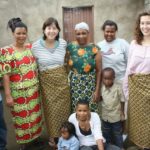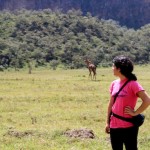Top Tips for Uganda Travel: Part 2

 In my last post, I talked about essentials to bring, getting around the country, medical precautions, and more. Now I’m going to share some additional tips for traveling to Uganda so that you’ll know what types of food and languages to expect and how to be respectful of Ugandan culture.
In my last post, I talked about essentials to bring, getting around the country, medical precautions, and more. Now I’m going to share some additional tips for traveling to Uganda so that you’ll know what types of food and languages to expect and how to be respectful of Ugandan culture.
Uganda Travel: Top Tips for Uganda Travel, Part 2
Clothing & Laundry
When it comes to clothing, the general rule is to “look smart.” Aim to look your best—even if the faucets stopped running the night before and you resorted to a baby wipe bath. The closer your attire is to that of a modest outfit you would wear to an impressive interview, the more likely you are to gain high respect from your Ugandan counterparts. Skirts that cover the knee are a key component, but pants are fine too.
Oftentimes attempts to conform to these cultural expectations lead travelers to rely on beige and green varieties of loose “safari” clothing or on maxi-length beach attire that is see through or sleeveless. But modesty doesn’t translate directly to those items you would otherwise store away at home! Get classy about it! Match your favorite bright colored earrings and shoes with an empire-waist knee length skirt, and you’ll have compliments flying your way. Avoid walking out of the house in spandex leggings or shorts, but do focus on utilizing those dressy items you love.
If you will be partaking in some physical activity, aim for loose-fitting breathable capris or pants and dri-fit shirts. Make sure that whatever you bring can be hand-washed. Hotels usually have a laundry service (for a fee) with a 1-2 day turnaround, but travel detergent is a good idea just in case. Don’t be surprised if they refuse to wash your underwear; it is often expect you will hand-wash your own.
Food
When you’re spending more time in rural areas or away from western-oriented accommodation or restaurants, Ugandan food will likely be your only predominant option (and it’s cheap). But for the most part, travelers tend towards areas with a greater variety of food. Indian and Ethiopian restaurants are very common, but there’s even Greek, Mexican, Korean, and more, if you’re in the right place! If you’re in Kampala, you’ll have so much to choose from that you could even get by without eating a “local” meal. But that doesn’t mean you should avoid it!
Starches, starches, meat, starches. This will be your predominant impression of Ugandan food. Local options have slight variations depending on your particular location, but the common starches include:
- Matooke: Green bananas (similar to plantain) are steamed in their own leaves and mashed. Thick like hearty mashed potatoes but with a little stickiness. In the central region, it’s not a meal without matooke.
- Posho: Maize meal is ground, refined, and cooked in a manner that it becomes like a bread with a pliable, soft consistency that shapes well for scooping up soupy mixtures. Pretty flavorless, but filling! (Known as ugali in the rest of East Africa
- Irish: Boiled potatoes.
- Sweet Potato: This is not the orange yam-like ones but white and with a more subtle sweetness. Usually boiled, sometimes fried.
- Cassava: A starchy root with a consistency similar to potatoes that is sually boiled, sometimes fried.
- Rice: Rice.
- Chapati: This is like a delicious hybrid between a tortilla and naan but usually with a little bit more oil involved in the cooking process.
- Chips: Fries.
Usually you pick one to two of the available starches (they’ll bring you a full plate) and pair it with a meat stew (generally beef, goat, or chicken). Other common items to eat as side dishes, meat-less meals, or otherwise include: beans, peas, cabbage, groundnuts (made of a nut similar to peanuts), sim-sim (made of sesame), and fish. In the north, you get the delight of malakwang, which I’ll just let you experience.
Delicious and quick options that are also a common sight with street vendors include:
- Pork and other meat “muchomo”: It is generally grilled on a stick (like a kebab, nix the veggies).
- “Rolex”: An egg and veggie omelette are rolled up in a chapati. Usually about $1!
- Samosas: The same as the little triangular meat or veggie-filled snack usually found in Indian restaurants.
If you like spicy food, ask for “pili pili”! Usually the tiny fresh pepper, powder, or sauce is available as a condiment.
Vegetarian travelers can certainly maintain their diet while in Uganda, though depending on the circumstances and control over the food they consume, may get tired of rice and beans. I’ve known vegans that do, too, but they definitely take more control of their meals and have to be careful in restaurants.
But no matter what comes on the plate, it’s particularly important to accept food when it’s offered to you. It’s a courtesy that holds a lot of weight in Uganda. If you can—eat it all! If you’re stuffed—be honest, but try a few bites. If you really, really can’t eat it—assure them that your appreciation is genuine regardless. If welcomed into someone’s home for a meal, don’t be shocked if, as a female, you’re asked to give a little assistance. While most Ugandans will insist on treating any traveler as a guest, some may want to expose you to the “custom” of women doing the work or would appreciate the gesture of you trying.
Traveling Solo
Traveling solo as a female through Uganda may seem daunting, but it IS possible! Though, of course, you should always keep your safety in mind. Walking alone, being alone, and traveling alone in general certainly can open you up to risk, catcalls, and the like. It’s always best to be confident and plan ahead. Knowing where you are going and showing your familiarity is a key item that can change an entire scenario, but it’s not foolproof. Certain situations—like being in the bus park at night and alone—should definitely be avoided completely. And no matter your gender—NEVER leave your things unattended!
Traveling with Kids
If you’re traveling with infants or kids, you’ll find that there is plenty to entertain! Uganda has a very patriarchal society, but there is a high level of respect for the childbearing process and the role of parenthood. Breastfeeding does not have to be hidden. Infants and children are welcome into almost all spaces. Your kids will have hundreds of insta-friends and can partake in many of the types of safaris and excursion there are available. But! You may want to go with a private hire for your transport around the country, as all other forms of transport may have you stuck in unreliable and uncontrolled conditions (not what you want to deal with anytime but especially not with a child in tow!).
Greetings & Languages
Though a simple Google search might tell you that Swahili is the language spoken in Uganda, it is not commonly used unless you are close to the Kenyan border. As with most African nations, the languages spoken across the country vary greatly. However, there is a lot of crossover, and most individuals have familiarity with multiple dialects. English is the official language within government and schools, so most Ugandans speak English—ranging from a basic grasp to complete fluency. If you know English, you won’t have to worry about getting by at any point. However, knowing some of the local language can add a great deal to your experience!
A basic map of the most common languages can be found on Wikipedia, but here is a little more information regarding the two languages that I have the most familiarity with, and that also cover a wide expanse of the country. In the Central Region, Luganda is the most common language. A few common words or phrases (with informal pronunciation in parentheses):
- Weebale (whe-bva-lay) – thank you (to one person)
- Mwebale (mwe-bva-lay) – thank you (to more than one person)
- Ssebo (say-boww) – sir
- Nnyabo (nye-bow*) – madam
- Mazzi (a-mah-ze)– water
- Nze [insert name] – “I am called [insert name]”
In the North, Acholi is the most common language. A few common words or phrases (with informal pronunciation in parentheses):
- Apwoyo (ah-foy-oh) – thank you
- Kopango? (co-peyn-go) – How are you? (Informal)
- Kope (co-pey) – I’m good. (Informal)
- Icoo ma ber? (ee-cho ma bay) – Is it a good morning?
- Acoo ma ber. (ah-cho ma bay) – Yes it is a good morning.
- Pwudi apwonyo apwonya (foo-di afon-yo afon-ya) – I am just learning.
Places to Go
Most of all, don’t anticipate staying in one place! There’s so much to see, but here’s a few ideas to get you started:
- Lake Bunyonyi and the southwest corner of the country: This region is incredibly beautiful, full of hiking opportunities, gorilla trekking, and wonderful for swimming!
- Jinja: It has much to offer, from whitewater rafting, kayaking, swimming, rope swings, ATVs, and on and on!
- Fort Patiko: Visit if you want to camp with the best views of an amazing sunset, night skies, and an early sunrise.
Accommodation
- New City Annex Hotel of Kampala: It is perfectly located in the city center, near the PostBus, and fairly priced.
- YES Hostel of Fort Portal: This is a fairly priced hostel supporting a great cause, with the bonus of a ping-pong table and the potential of hot-out-of-the-oven freshly baked goods for sale from the director.
- Cosmo Guest House of Gulu: It is reliable, affordable, and just near the center of town.
- Entusi Resort on Lake Bunyonyi: Stay here if you like isolated and magical places.
Restaurants
- Duchess in Fort Portal: Oriented towards foreigners, with amazing Korean beef salad and mocha ice cream.
- Happy Nest: A solid and cheap choice for good local food in Gulu, just across from Cosmo Guest House.
- The Iron Donkey: A new café and guest house in Gulu, serving up scrumptious items including the most perfect oatmeal chocolate chip cookie.
- TAKS Art Centre Gulu: All about their pork and chips, with some kind of magical sauce on it.
- The Little Donkey: A Mexican restaurant in the middle of Kampala. It makes no sense but the margaritas are actually magic.
Uganda Travel: Top Tips for Uganda Travel, Part 2 photo by Unsplash.








